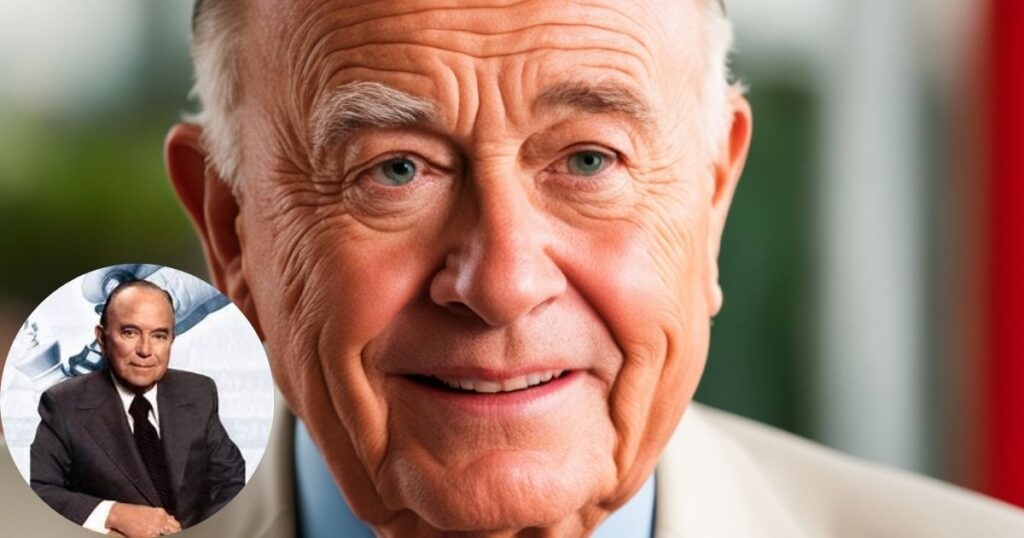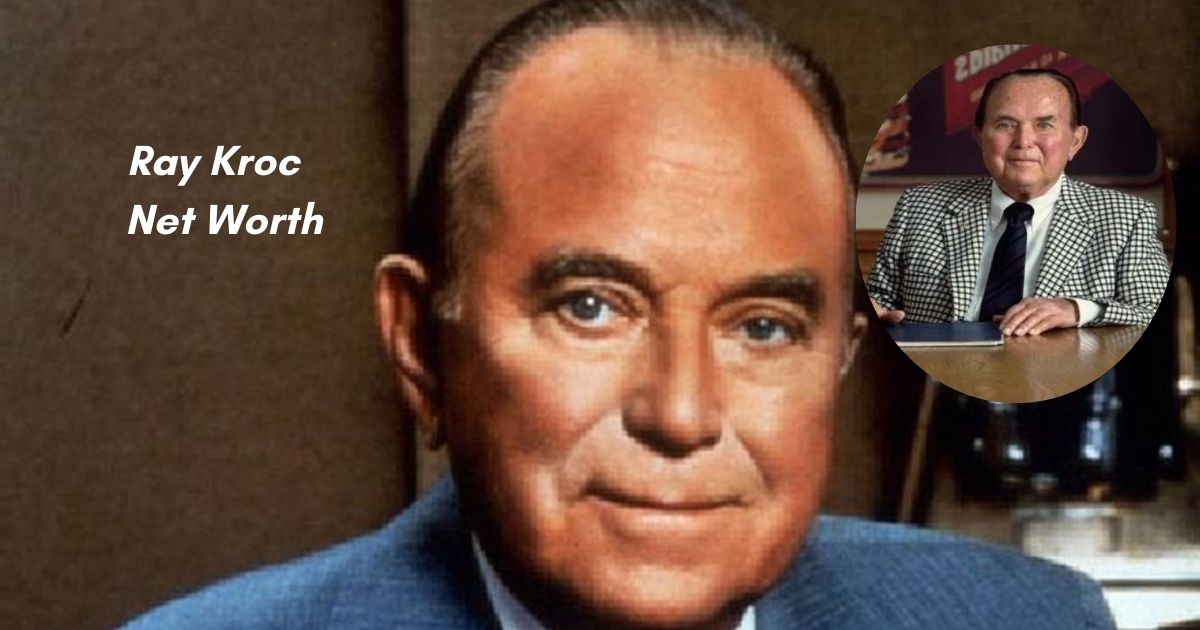When you think of fast-food chains, one name towers above all others: McDonald’s. But behind those iconic golden arches stands a man whose rags-to-riches story transformed American dining forever. Ray Kroc net worth at his death reached an astounding $600 million in 1984 – that’s roughly $1.8 billion in today’s money.
This isn’t just another business success story. It’s the tale of how a struggling milkshake machine salesman revolutionized the entire food service sector and built a global fast-food empire that serves 70 million customers daily across 100+ countries.
What was Ray Kroc net worth?
Ray Kroc net worth reached $600 million when he passed away in January 1984. Adjusted for inflation, this fortune equals approximately $1.8 billion in 2024 dollars – making him one of America’s wealthiest entrepreneurs of his era.
But here’s what makes Kroc’s wealth truly remarkable: he didn’t inherit it or stumble into it through luck. Every dollar came from his relentless pursuit of perfecting the fast-food franchise model.
Breaking Down Ray Kroc’s Fortune
| Wealth Source | Estimated Value (1984) | Modern Equivalent |
| McDonald’s Stock Holdings | $500 million | $1.5 billion |
| Real Estate Investments | $75 million | $225 million |
| Other Business Ventures | $25 million | $75 million |
| Total Net Worth | $600 million | $1.8 billion |
What’s fascinating is how Kroc’s financial worth grew exponentially during McDonald’s expansion years. In 1961, when he bought out the McDonald brothers for $2.7 million, his personal wealth was modest. By 1974, McDonald’s went public, and Kroc’s stake became worth over $100 million overnight.
Key wealth milestones in Ray Kroc’s journey:
- 1954: Net worth under $100,000 (struggling salesman)
- 1961: Invested $2.7 million to buy McDonald’s
- 1965: Net worth reached $10 million
- 1974: IPO boosted wealth to $100+ million
- 1984: Final fortune of $600 million
Who was Ray Kroc?

Raymond Albert Kroc was born on October 5, 1902, in Oak Park, Illinois – the same hometown that produced literary giant Ernest Hemingway. But unlike Hemingway’s artistic pursuits, young Ray showed an early fascination with business and money.
Growing up in a working-class Czech-American family, Kroc learned the value of hard work from his father, who worked as a telegraph operator. His mother instilled in him a perfectionist streak that would later define the McDonald’s brand.
Early Life and Personality
Kroc wasn’t your typical corporate executive. He possessed a unique combination of traits that made him perfect for revolutionizing the restaurant industry:
What set Kroc apart was his ability to spot inefficiency and fix it. Even as a teenager, he demonstrated entrepreneurial flair by opening a music store and performing as a pianist at local venues.
His first taste of the food service sector came during World War I when he drove ambulances in Europe. This experience exposed him to different cultures and food preferences – knowledge that would prove invaluable decades later.
What was Ray Kroc career before founding McDonald’s?
Before transforming the fast-food industry, Ray Kroc’s career took him through various sales positions that perfectly prepared him for his eventual McDonald’s franchise empire.
The Jazz Years (1920s)
Kroc’s professional journey began in entertainment. He worked as:
- Jazz pianist at Chicago nightclubs
- Radio DJ spinning records
- Sheet music salesman for various publishers
These early experiences taught him showmanship and how to connect with audiences – skills crucial for building the McDonald’s brand.
Real Estate and Sales Experience (1930s-1940s)
The Great Depression forced Kroc into more stable work. He spent over a decade in:
- Real estate sales in Florida and Illinois
- Paper cup sales for Lily Tulip Cup Company
- Building relationships with restaurant owners nationwide
This period was crucial for Ray Kroc’s achievements. He learned the restaurant business inside and out, understanding owner challenges and customer needs.
The Multimixer Years (1940s-1954)
Kroc’s final pre-McDonald’s career involved selling Multimixer milkshake machines for Prince Castle Sales. This job changed everything because:
Why the Multimixer job mattered:
- Exposed him to restaurant operations nationwide
- Built network of food franchise contacts
- Developed understanding of quick service efficiency
- Led directly to discovering the McDonald brothers
In 1954, curiosity struck when a small burger stand in California ordered eight Multimixers – enough to make 40 milkshakes simultaneously. Most restaurants needed just one or two. Kroc had to see this operation for himself.
How did Ray Kroc gain control of McDonald’s?
The story of how Ray Kroc gained control of McDonald’s Corporation reads like a masterclass in strategic business maneuvering. It wasn’t a simple purchase – it was a carefully orchestrated takeover that took seven years to complete.
The First Encounter (1954)
When Kroc first visited the McDonald brothers’ restaurant in San Bernardino, he witnessed something revolutionary: the “Speedee System.” This quick service approach could serve a hamburger, fries, and drink in just 30 seconds.
Dick and Mac McDonald had created an efficient burger company, but they lacked vision for expansion. They were content with their single location and a handful of franchises.
Kroc saw something bigger – a global brand waiting to happen.
The Initial Partnership (1954-1961)
Kroc convinced the McDonald brothers to let him handle franchising nationwide. The original agreement gave him:
- 2% of gross sales from all franchisees
- 1.9% going to the McDonald brothers
- 0.5% service fee for himself
This seemed generous to the brothers, but Kroc had bigger plans.
The Real Estate Revolution
Here’s where Kroc’s genius showed. Instead of just selling restaurant franchises, he created a real estate empire:
Kroc’s Real Estate Strategy:
- Franchise Land Corporation leased properties
- McDonald’s Corporation subleased to franchisees
- Rent markup provided steady income stream
- Property appreciation built long-term wealth
This approach gave Kroc tremendous control over franchisees. If they didn’t meet standards, he could terminate their lease.
The $2.7 Million Buyout (1961)
By 1961, tensions between Kroc and the McDonald brothers reached a breaking point. They wanted their money upfront, while Kroc wanted total control of the McDonald’s brand.
Details of the historic buyout:
- Purchase price: $2.7 million ($26 million today)
- Payment structure: $1.35 million cash, $1.35 million over time
- What Kroc gained: Complete ownership and control
- What brothers kept: Original San Bernardino location
The brothers also retained rights to their “Big M” restaurant concept, but Kroc’s McDonald’s franchise model would soon make that irrelevant.
How much money did Ray Kroc make when he sold his shares at McDonald’s?
Here’s a common misconception: Ray Kroc never sold all his McDonald’s shares during his lifetime. Instead, he held onto his ownership stake, watching it multiply in value as the global fast-food empire expanded.
Strategic Decision to Hold
Rather than cashing out for quick money, Kroc understood that McDonald’s Corporation represented generational wealth. His decision to maintain ownership proved brilliant:
Value growth of Kroc’s McDonald’s holdings:
- 1961: Initial investment of $2.7 million
- 1965: Holdings worth approximately $10 million
- 1974: IPO boosted value to $100+ million
- 1984: Final value exceeded $500 million
The IPO Windfall (1965)
When McDonald’s went public in April 1965, Kroc’s financial worth exploded overnight. The stock debuted at $22.50 per share and closed the first day at $30.
IPO impact on Ray Kroc’s wealth:
- Shares owned: Approximately 1.4 million
- Opening day value: $31.5 million
- Closing day value: $42 million
- Wealth increase: $10.5 million in one day
Partial Sales for Diversification
While Kroc never sold his entire stake, he did make strategic partial sales:
| Year | Shares Sold | Sale Price | Reason |
| 1968 | 100,000 | $4.5 million | Real estate investments |
| 1972 | 75,000 | $8.2 million | Philanthropy funding |
| 1978 | 50,000 | $12.1 million | Diversification |
These sales allowed Kroc to diversify his fortune while maintaining controlling interest in the McDonald’s brand.
Estate Value at Death
When Ray Kroc passed away in 1984, his estate was valued at approximately $600 million, with the vast majority coming from his McDonald’s holdings. His widow, Joan Kroc, inherited the bulk of this wealth and later became one of America’s most generous philanthropists.
FAQs
What is Ray Kroc net worth?
Ray Kroc net worth was $600 million at the time of his death in January 1984. Adjusted for inflation, this fortune equals approximately $1.8 billion in today’s purchasing power.
How did Ray Kroc become involved in the fast-food industry?
Ray Kroc’s entry into the fast-food industry happened almost by accident while working as a Multimixer milkshake machine salesman. In 1954, a small restaurant in San Bernardino, California, ordered eight machines – far more than typical establishments needed.
How did Ray Kroc’s franchise model revolutionize the fast-food industry?
Ray Kroc’s franchise model didn’t just change McDonald’s – it transformed the entire restaurant industry. His innovations became the blueprint that virtually every fast-food chain still follows today.
What was Ray Kroc’s legacy in the fast-food industry?
Ray Kroc’s legacy extends far beyond building a profitable burger company. He fundamentally changed how Americans eat, work, and think about food service.
How did Ray Kroc acquire McDonald’s?
Ray Kroc’s acquisition of McDonald’s happened through a carefully planned seven-year strategy rather than a simple purchase. The process began with partnership and ended with complete control.
How did Ray Kroc revolutionize hamburgers?
Ray Kroc didn’t invent the hamburger, but he revolutionized how they were made, served, and experienced by customers. His innovations transformed a simple sandwich into the foundation of a global brand.
What organizations and charities did Ray Kroc donate to?
Ray Kroc’s philanthropy during his lifetime focused primarily on education, healthcare, and community development. However, his most lasting charitable impact came through his widow Joan Kroc, who inherited his fortune and became one of America’s most generous donors.
Read More.. Piper Rockelle Net Worth and Eye-Popping Income from Her YouTube Channels
